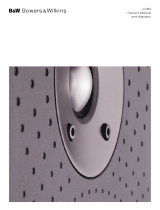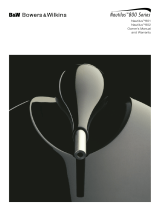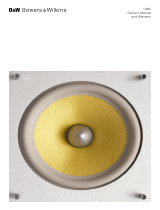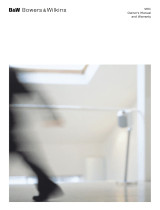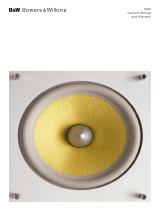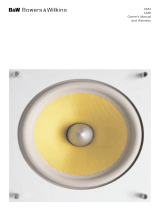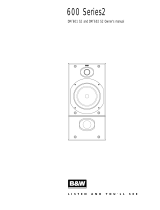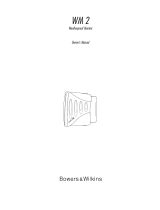
i
ndependently. Bi-wiring can improve the resolution of
low-level detail. Figures 3a and 3b illustrate
c
onventional and bi-wire connection.
E
nsure that positive terminals on the speaker (marked
+ and coloured red) are connected to the positive
o
utput terminal on the amplifier and that negative
t
erminals on the speaker (marked – and coloured
black) are connected to the negative output terminal
o
n the amplifier. Incorrect connection can result in
poor imaging and loss of bass.
Ask your dealer for advice when selecting speaker
cable. Keep its total impedance below the maximum
recommended in the speaker specification and use a
low inductance cable to avoid attenuation of high
f
requencies.
Fine Tuning
Before fine tuning, make sure that all the connections
in the installation are correct and secure.
Moving the speakers further from the walls will
generally reduce the volume of bass. Space behind
the speakers will also help to create an aural
impression of depth. Conversely, moving the speakers
closer to the walls will increase the volume of bass. If
you want to reduce the volume of bass without
moving the speakers further from the wall, fit the foam
plugs in the port tubes as illustrated in Figure 4.
If the bass seems uneven with frequency this will most
probably be due to resonance modes in the listening
room. Even small changes in the position of the
speakers or the listening position can have a profound
effect on how these resonances affect the sound. Try
moving the listening position or locating the speakers
along a different wall. The presence and position of
large pieces of furniture can also influence resonance
modes.
If the central image lacks focus, try moving the
speakers closer together or angling them inward so
that they point at a location just in fr
ont of the listening
position. Figure 2b illustrates speakers angled inwards.
If the sound is too bright, increasing the amount of
soft furnishing in the room (heavier curtains for
example) may help balance the sound. Conversely,
reducing the amount of soft furnishing may help
brighten a dull sound.
Some rooms suffer from “flutter echoes” – echoes that
“bounce” between parallel room boundaries. Flutter
echoes can colour the sound of the speakers in the
room. Test for flutter echoes by standing in the middle
of the room and clapping your hands. Flutter echoes
can be reduced by placing irregular shaped items or
non-reflective surfaces, bookshelves, rugs or pictures
for example, on one of the offending walls or floor.
Ensure that the speaker stands firmly on the floor. Use
carpet pier
cing spikes if appr
opriate and adjust them
to take up any unevenness.
Running-in Period
The performance of the speaker will change subtly
during the initial listening period. If the speaker has
been stored in a cold environment, the damping
c
ompounds and suspension materials of the drive
units will take some time to recover their correct
m
echanical properties. The drive unit suspensions will
also loosen up during the first hours of use. The time
t
aken for the speaker to achieve its intended
p
erformance will vary depending on previous storage
conditions and how it is used. As a guide, allow up to
a
week for the temperature effects to stabilise and
1
5 hours of average use for the mechanical parts to
attain their intended design characteristics.
However, longer run-in periods (as long as a month)
h
ave been reported and there is evidence to suggest
that this has little to do with the speaker changing and
more to do with the listener getting used to the new
sound. This is especially so with highly re
vealing
s
peakers such as these where there may be a
significant increase in the amount of detail compared
with what the listener has previously been used to; the
sound may at first appear too “up front” and perhaps
a little hard. After an extended period of time the
sound will seem to mellow, but without losing clarity
and detail.
Aftercare
The cabinet surfaces usually only require dusting. If
you wish to use an aerosol or other cleaner, remove
the grille first by gently pulling it away from the
cabinet. Spray aerosols onto the cleaning cloth, not
directly onto the product. Test a small area first, as
some cleaning products may damage some of the
surfaces. Avoid products that are abrasive, or contain
acid, alkali or anti-bacterial agents. Do not use
cleaning agents on the drive units. The grille fabric
may be cleaned with a normal clothes brush whilst the
grille is detached from the cabinet. Avoid touching the
drive units, especially the tweeter, as damage may
result.
Limited Warranty
This product has been designed and manufactured to
the highest quality standards. However, if something
does go wrong with this product, B&W Group Ltd. and
its national distributors warrant free of charge labour
(exclusion may apply) and replacement parts in any
country served by an official B&W distributor.
This limited warranty is valid for a period of five years
from the date of purchase or two years for electronics
including amplified loudspeakers.
Terms and Conditions
1
The warranty is limited to the repair of the
equipment. Neither transportation, nor any other
costs, nor any risk for removal, transportation and
installation of products is covered by this warranty.
2
This warranty is only valid for the original owner
. It
is not transferable.
3
This warranty will not be applicable in cases other
than defects in materials and/or workmanship at
the time of pur
chase and will not be applicable:
3
6191 683-684 manual Inside 30/4/07 2:19 pm Page 3







